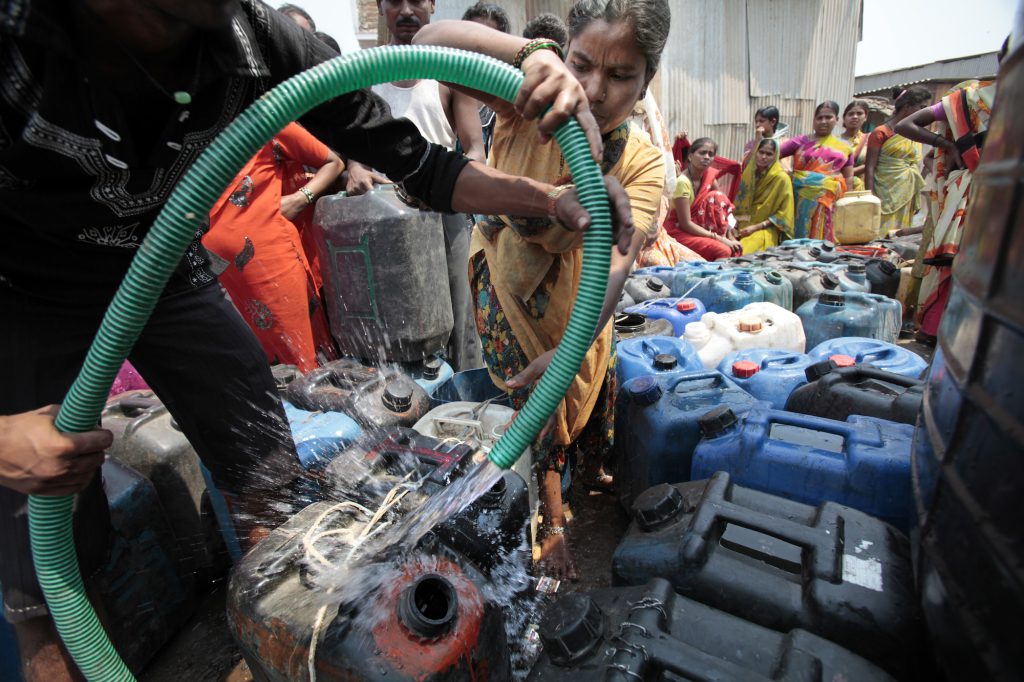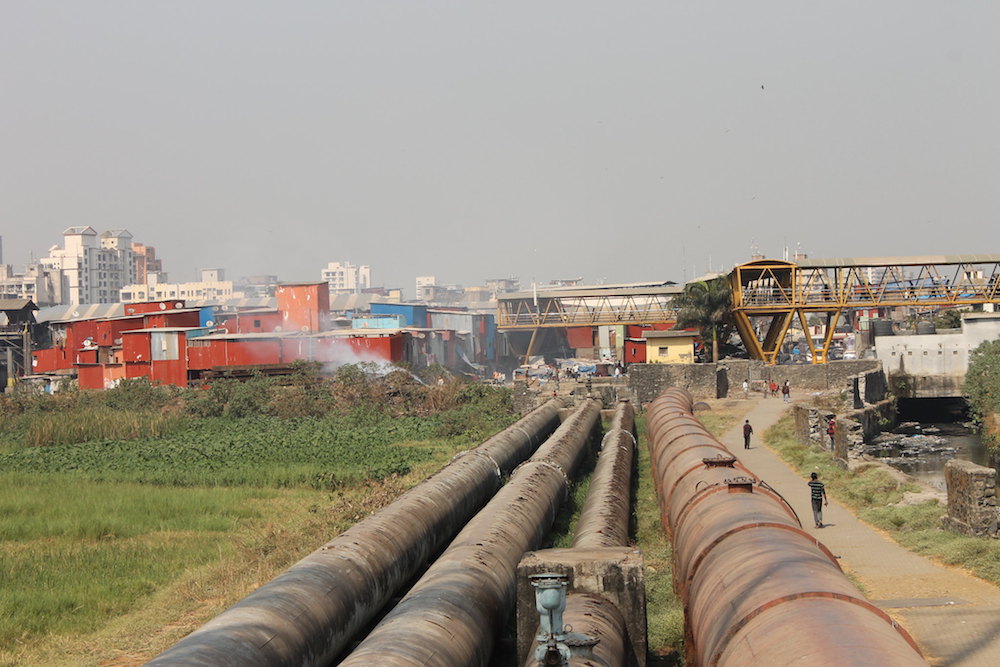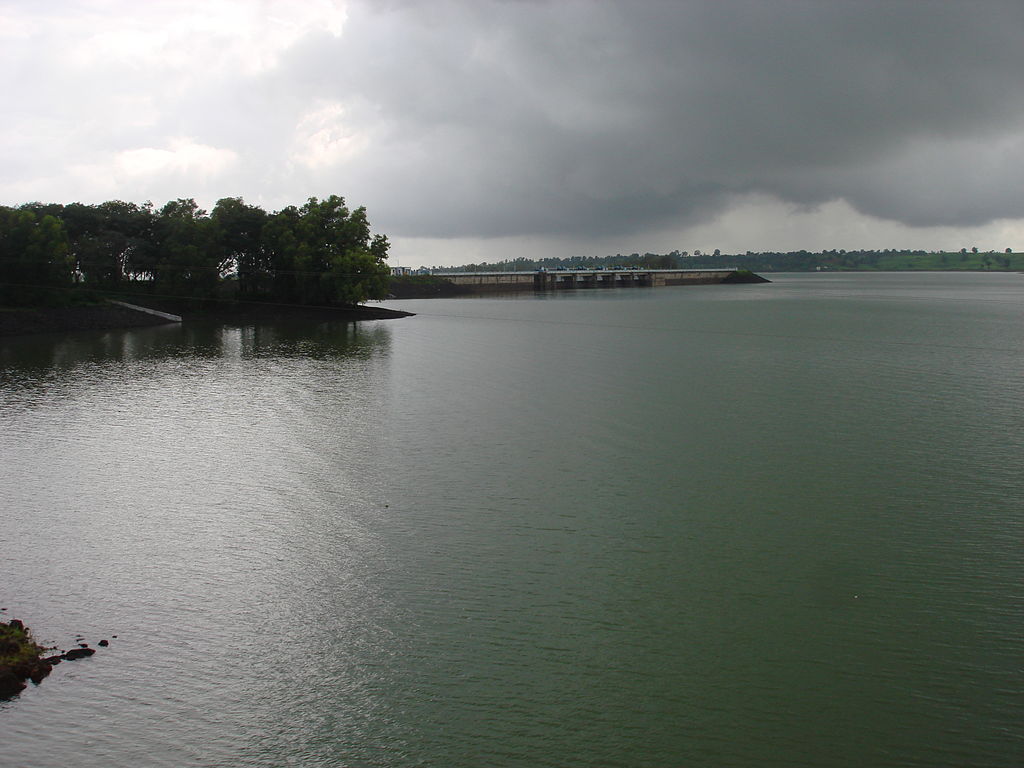Searching for the Sources of Water Scarcity

Nikhil Anand, an environmental and urban anthropologist, grew up in Mumbai, India. In 2007, after studying and working in the U.S., he returned to Mumbai to research urban infrastructure and, in his field work, met a woman, Alka tai, a first-generation immigrant to Mumbai. [1] [1] Tai is a common term in Marathi, a language spoken in Mumbai, that is used to refer to older women and means “big sister.”
Alka tai invited him to her home, a small house alongside a narrow alleyway. Though only 20 kilometers from his parent’s apartment, Alka tai’s neighborhood was markedly different from Anand’s. She was a longtime resident of the Meghwadi settlement, an area largely established “informally,” that is, without the permission of the state.
Most of Meghwadi’s residents were migrants from surrounding areas. They did not, at least initially, have legal rights to the land on which their houses stood. For that reason, Anand expected to find a home filled with absences—a structure without the recognition of the state and missing basic physical infrastructure.
He didn’t expect to find a two-storied brick-and-mortar home in the middle of a well-planned grid, with tiled floors and curtains. Alka tai’s children were studying English books under an electric fan. Most surprising of all, her home had internal plumbing that reminded him of the water infrastructure in his own home.
“We have everything,” Alka tai told him. As Anand reveals in his 2017 book Hydraulic City, Alka tai and her neighbors made gains gradually, through a discrete and graded accumulation of government services. She herself worked to help other residents gain admission to schools and hospitals. Within a few decades, she explained, residents even secured a place in the electoral rolls of the city.
Yet the city withheld one precious service longer than the rest: water.
Anand’s discussions with Alka tai spurred him to dig deeper into water usage in Mumbai. He uncovered a complex story. To get a water connection, Alka tai and her neighbors needed to prove that their homes had existed in Mumbai for nearly 20 years. Even afterward, they might only receive a small quantity of water through narrow pipes at restricted times and with low water pressure.
Journalists report narratives of water shortage, overabundance, and ill-usage throughout India. Many regions experience an annual monsoon, in which heavy rainfall follows a dry spell. But human-driven climate change is making both the dry and wet periods more extreme. And India as a nation has concerns about providing enough drinking water for the growing population.
In Mumbai, officials justify strict measures like those in Meghwadi by saying that houses in these neighborhoods—often not equipped with dishwashers, flush toilets, or showers—need less water than homes in other areas. They also point to water scarcity before monsoons to suggest there is not enough water for all citizens to share.
Anand disagrees. Now a professor of anthropology at the University of Pennsylvania, Anand has studied this issue for more than a decade. He argues that there is enough water to go around.
Anand believes that, due to a number of factors, including crumbling infrastructure and leaks, water in Mumbai is extremely difficult to monitor. As a result, government officials can effectively choose who receives water, and narratives of water shortage can justify social inequities—creating islands of abundance and scarcity within the city.
Mumbai receives most of its water from watershed regions in the neighboring Thane district. There, dams supply the city with more than 3 billion liters daily (enough water to fill 1,200 Olympic swimming pools).
Anand observes that this flow should be enough to supply 150 liters each day to every resident of Mumbai—enough, in short, for everyone. For comparison, Germany has a per capita consumption of about 120 liters each day.
The trouble, Anand contends, is not in supplying but in tracking water. Mumbai is not alone. This problem plagues many countries. For instance, according to data from 2015, on average, just under half of the water entering Italy’s national water distribution networks is lost to leakages.
In Mumbai, when water first enters the city from the Thane district’s dams, it is still safely in the domain of measurable pipes and networks. The dams themselves have been meticulously planned and executed. They push untreated freshwater toward a primary network of giant pipes that funnel it to treatment plants. From there, a secondary network carries treated water toward reservoirs in the city.
But within Mumbai, Anand says, a city engineer will tell you that the “official” information on pipes and water supply falls short. These engineers must call up retired colleagues who have an intimate knowledge of leaks and unauthorized connections to get an accurate sense of existing infrastructure. A World Bank–sponsored study released in 2007 found that more than a third of the water in one of Mumbai’s largest localities was leaking from its pipes (although the municipality itself contested this figure).
Some leaks come from aging infrastructure. Worn or rusted joints and pipes release water into the soil. That water may reach underground aquifers and be accessed as groundwater. It may also leach into saline backwaters or, eventually, the sea. In other places, it may combine with sewage and become contaminated.
Such leaks are not uncommon in other large cities around the world. The Delaware Aqueduct supplying water to New York City has been leaking an estimated 20 million gallons a day for several decades, for example.
Wear and tear to Mumbai’s water infrastructure come from many sources. Veena Srinivasan at the Ashoka Trust for Research in Ecology and the Environment, Bangalore, points out that, for most large cities in India, it can be difficult to supply both the water and pressure needed to ensure citizens can turn on their taps anytime 24/7. After periods of water scarcity or power shutdowns, the infrastructure may develop additional breaks—and water pulsing through the system at variable pressures also causes leaks.
More than a third of the water in one of Mumbai’s largest localities was leaking from its pipes.
In order to reduce such water waste, the city does not supply people with continuous water. (People with sufficient resources fill up storage tanks and connect the taps inside their homes and offices only to these storage devices. They create an illusion of uninterrupted, abundant water.)
Since water flows through pipes intermittently and at varying pressure, meters are often inaccurate when measuring volumes—adding another layer of difficulty in accurately tracking the city’s water.
But there’s another way that water goes missing in Mumbai, one driven by desperation. “When some residents are unable to access water regularly and legally, social leaks are inevitable,” says Anand. That is, communities without legitimate access to water create unauthorized connections and piping. This water can neither be measured nor billed.
Mumbai has a recent history of exceptional trauma. In 1992 and 1993, a series of terrorist bomb blasts and communal riots contributed to tensions between Hindu and Muslim communities and yanked at the multicultural threads holding the city together.
In the years to follow, many communities began to consolidate their living spaces along religious or regional identities. Migrant Muslims gravitated toward homes in informal settlements with Muslim majorities such as Premnagar, a neighborhood in Mumbai, even when they could afford better housing.
In Premnagar, Anand discovered that residents believed their religion and migrant status contributed to the local administration’s neglect of water infrastructure in the area. From the late 1990s onward, a network of local plumbers had been quietly adding unauthorized connections to the system, supplying water—erratically—to residents.
Many people in Premnagar believed that without this effort, they would receive no water at all. After speaking with municipal officials, Anand suspects this belief may have been justified. Still, these unauthorized connections created new problems.
Once the municipality realized the extent to which Premnagar relied on such breaches, it no longer maintained even the legitimate connections, allowing the infrastructure to fall into disrepair. In turn, these actions fueled greater distrust.
Anand has also documented a vicious cycle related to migration and water use. As politicians and city officials insist that Mumbai is running out of water, long-standing residents in the city perceive newly arrived immigrants as a threat to this limited resource. Such narratives have nourished entire political movements in the region.
“Simultaneously,” Anand says, “the feeling of insufficient water also allows the city to lay claim to large amounts of surface water from its neighboring regions.” The result, ironically, drives more people into Mumbai.
For instance, the rivers and dams of Shahapur, a town in the Thane district, help supply Mumbai’s water. But farmers in Shahapur do not have enough to irrigate their land, so many move to Mumbai. These people are denied water twice over: once in their villages when surface water is harnessed by the city and once again in Mumbai, where they have to work extra hard to access the same water.
Sitaram Shelar, who works with an advocacy group called the Center for Promoting Democracy, helps settlers get water connections. At present, he says, there are 54 communities in Mumbai that don’t have access to municipal water.
The alternative is water from sources such as tankers, privately owned trucks that drive in water, which, Shelar says, can cost significantly more than municipal water. (Shelar estimates it can cost 140 times more; a World Resources Institute study suggests it’s 52 times more.)
Shahapur’s farmers are denied water twice: once in their villages and again in Mumbai.
Given the cost, people use water minimally, which creates other problems. “When they don’t bathe often or drink enough water, there are long-term effects on health,” Shelar says, referencing the spread of skin disease and urinary tract infections in particular.
The Safe Water Network, a nonprofit water development organization, published a report in 2016 that noted that, in some seasons, most people in Mumbai’s informal settlements use less than 50 liters of water a day. For context, the United Nations has stated that people should have access to 50 to 100 liters of water per capita daily. For many residents of Mumbai, meanwhile, a daily per capita usage of 250 liters is currently within reach.
Mumbai’s history can help explain its current predicament. British officials installed the first components of a rudimentary water system in 1860, when the city was a trading center for the British Empire. There was a well-maintained, carefully planned colonial city and a more chaotic, poorly serviced outer city for the local population. Today, explains Anand, this model persists: Some citizens are treated as though they are more deserving of public utilities than others.
Despite its distinct history, Mumbai can offer lessons for other cities. “Many cities across the world deny some residents access to safe water,” Anand says. Some authorities directly deny people applying for water connections. Others price water beyond the reach of some parts of the population.
According to a 2017 study, nearly 14 million households in the United States could not afford their water bills in 2014. Between 2010 and 2016, the price of water in 30 major U.S. cities increased by more than 40 percent, mostly due to crumbling infrastructure. In the city of Philadelphia, for example, 86,000 households had their connections cut off at least once between April 2012 and May 2017. Often these residents were people of color living in low-income households.
Anand believes that urban centers need two basic prerequisites for equitable, 24/7 water supply for everyone. “First, the administration must perceive its residents as an undifferentiated whole,” he says. In other words, the right to access safe water should be universal and inviolable. Otherwise, Anand predicts, social leaks will be common.
Second, Anand notes, the city must commit to maintenance. A leaky system is predisposed toward scarcity, unequal distribution, and intermittent supply. Too often, he adds, politicians prioritize finding new sources of water over caring for the existing infrastructure.
Although only starting points, these strategies could go a long way toward establishing water equity. In an era of climate change, fresh water is likely to become scarcer even as migrations will become more common.
As Alka tai pointed out when Anand visited her home 12 years ago, “If we don’t have water, what is the use of everything else?”


































